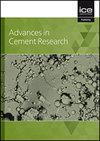热活化对锂矿渣-水泥复合粘结剂水化性能的影响
IF 1.3
4区 工程技术
Q3 CONSTRUCTION & BUILDING TECHNOLOGY
引用次数: 0
摘要
为了提高锂渣在水泥基材料中的利用效率,对锂渣进行了钙化和热活化,并对其活化机理进行了分析。结果表明:LS中的石膏和锂辉石在高温下通过钙化和热活化进行分解,而锂辉石和石灰石在高温下煅烧分解,生成更多的CS、CA等矿相。钙化和热活化可以增强LS参与火山灰反应的活性,生成更多水化产物。LS经钙化和热活化后,LS复合粘结剂的水化放热峰、水化总热量和水化产率均显著提高。硬化后的基体更致密,孔隙率更低。与掺入生料LS相比,掺入钙化LS和热活化LS可使水泥砂浆在3d、7d和28d的抗压强度分别提高25.8%、13.4%和20.5%。本文章由计算机程序翻译,如有差异,请以英文原文为准。
Effects of thermal activation on the hydration performance of lithium slag-cement composite binder
In order to enhance the utilization efficiency of lithium slag (LS) in cement-based materials, calcificated and thermal activation of LS were conducted, and the activation mechanism have been analyzed. Results showed that gypsum and spodumene in LS decomposed at high temperature via calcificated and thermal activation, and spodumene as well as limestone calcination decomposed at high temperature, to generate more CS, CA and other mineral phases. Calcificated and thermal activation could enhance the activity of LS to participate in pozzolanic reaction, and generate the formation of more hydration products. After calcificated and thermal activation of LS, the hydration exothermic peak, the total amount of hydration heat, and hydration production of LS composite binder were significantly increased. The hardened matrix was more compact with less porosity. Compared with cement mortar incorporated with raw LS, the incorporation of calcificated and thermal activated LS enhanced the compressive strength of cement mortar at 3d, 7d, and 28d by 25.8%, 13.4%, and 20.5%, respectively.
求助全文
通过发布文献求助,成功后即可免费获取论文全文。
去求助
来源期刊

Advances in Cement Research
工程技术-材料科学:综合
CiteScore
3.70
自引率
5.00%
发文量
56
审稿时长
3.2 months
期刊介绍:
Advances in Cement Research highlights the scientific ideas and innovations within the cutting-edge cement manufacture industry. It is a global journal with a scope encompassing cement manufacture and materials, properties and durability of cementitious materials and systems, hydration, interaction of cement with other materials, analysis and testing, special cements and applications.
 求助内容:
求助内容: 应助结果提醒方式:
应助结果提醒方式:


